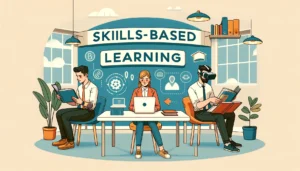MATCH Challenge: Speeding up transformation for 'slow-moving tankers'
- 6 Min Read
An engaging and productive company culture might not make up for a low salary, but it is becoming a competitive advantage in the job market, and CIOs are now becoming responsible for the tools and technologies to make it happen.
- Author: Richard Middleton
- Date published: Apr 10, 2019
- Categories

At the HRD Summits, we bring business leaders together for MATCH Meetings, where they discuss the greatest challenges facing their organizations, taking in everything from talent acquisition to cultural transformation.
Each week, we take a MATCH Challenge and put it to our community to find the answer. This week’s MATCH solution comes from Richard Middleton, Country Manager UK & Ireland, Lifesize.
MATCH Challenge: How can we speed up business transformation in ‘slow-moving tankers’?
An engaging and productive company culture might not make up for a low salary, but it is becoming a competitive advantage in the job market, and CIOs are now becoming responsible for the tools and technologies to improve the working environment for their people.
Just recently, Bank of New York Mellon reversed its unpopular move to ban working from home for its employees. Announcing the change, CEO Charles Scharf said, “while we believe that it is enormously helpful to have as many people as possible physically together working collaboratively, we also realise that changes can affect personal lives in many ways.”
Welcome to the new era of work-life balance and remote collaboration.
Treating employees with dignity is hardly a new idea. The great 19th century philanthropist-industrialists built model villages where workers could access a range of amenities. And Henry Ford had the revolutionary idea of paying workers $5 a day so they could afford the cars they helped to build. Fast forward to the Information Age, during which Mark Zuckerberg famously advised companies to treat employees right “so that they don’t use your Internet to look for a new job.”
Today, forward-leaning business leaders have understood there is a bottom-line business rationale when a more flexible way of working is considered the status-quo, rather than a benefit. What’s different is that the CIO now has an important, increasingly strategic role to play by providing the technologies that ensure employees can work in the way that they’re happiest and most productive. Moreover, they must help to shape an engaging, cohesive and trustworthy working culture.
What Millennials want
Aside from being the first digitally native cohort, Millennials now comprise the largest generation in the workforce. Providing them with the option to work remotely is not a case of pandering to their whims, but of enabling them to work most effectively.
For example, a study by TechSmith found that Millennials are twice as likely to prefer more visual communication methods compared to Baby Boomers, whilst two thirds say that they understand information faster when it’s communicated visually.
The good news is that remote working seems to be gaining ground in business, especially among younger workers. Those working from home make up 13.7% of the UK workforce, whilst nearly three quarters of younger managers (Millennial and Generation Z) have team members who work a “significant” portion of time remotely.
The benefits are clear, with employees 53% more likely to feel happy and productive at work.
But remote working requires more than securing permission from CIOs, HR or line managers. TechSmith found that almost half (44 per cent) of Millennials say that their employer’s communications are outdated. This puts CIOs in a highly unusual position, where their decisions about technology can have a critical impact on strategic questions of employee happiness and retention which was once far outside their remit.
The business case for remote working
In today’s knowledge economy, it’s becoming harder than ever to justify employees’ constant attendance in the workplace. The UK is an archetypal post-industrial society, where services make up more than 80 per cent of the economy. While some may need to be based in the office, many may not.
Indeed, recent research by the Centre for Business and Economics Research (CEBR) found that 57 per cent of the UK’s labour force – or more than 15 million people – work in roles that are eligible for remote working. The same study found that economic output would increase by over £20 billion a year if British workers ditched the commute.
Added to this are the intangible but very real benefits to employee morale, motivation, job satisfaction, health and wellbeing – all factors that HR are taking increasingly seriously from the view of both productivity and employee attraction / retention.
All this depends on having the right technologies in place, such as reliable, high-quality video conferencing systems that enable employees to share content and collaborate effectively wherever they are, especially amongst millennials who appreciate technology, like wearables, apps and workflow automation and communication, to aid productivity and streamline the process.
To rise to the occasion, video conferencing in the office must be a true one-click experience and accessible on whatever device is being used be it a mobile, laptop or tablet. It will need to be interoperable with other solutions and utilise WebRTC via the web browser to make video communication in the enterprise as simple as possible.
And to ease IT burdens, video conferencing solutions should be plug-and-play, so that HD cameras and phones work seamlessly with cloud-based conferencing software, no matter what size or type of room video is needed — huddle, conference, auditorium, etc. Cloud-based collaboration tools are helping companies provide workforces with faster and more efficient ways to communicate with each other. Real time chat tools are the norm in the majority of workplaces, and video conferencing is becoming increasingly popular. These more efficient methods of collaboration will eventually replace the majority of emails that we send.
Shaping a culture of trust and efficiencies
CIOs are in the perfect position to make the move away from email and secure investment in new communications, such as video conferencing, so that they can support and facilitate remote working. But there is an even more powerful argument for widening the scope of flexible working, and investing in the systems to make it a reality; trust.
Earlier this year, Gallup revealed in-depth research into how businesses can engage remote workforces. The company found that trust is essential. According to the report, when employees don’t trust organisational leadership, their chances of being engaged are one in 12. When they do trust their leaders, the chances of engagement leap up to 50 per cent.
CIOs now have an opportunity to ensure employees are supported by focusing on fostering a culture of seamless engagement and trust through video. Connecting people face-to-face is one way to facilitate trust through real-time collaboration and content sharing.
Employees are expert at differentiating between more and less meaningful benefits; above all, they can tell when the corporate leadership is truly committed to engagement. The challenge for CIOs is to consider questions of employee happiness, including flexible working, when they make technology investment decisions. Given the supreme strategic importance of human capital today, there can be few more urgent priorities on the CIO’s agenda. The question is…are they ready?









